2-2-1 fullcourt zone press
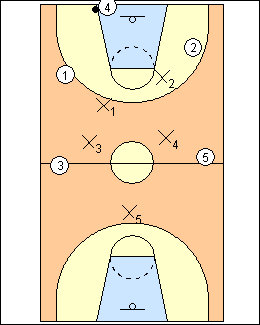 | 1 The basic 2-2-1 is a containing press to use up the shot clock, but also has good trapping opportunities and less risk than a 1-2-1-1, which emphasizes an early trap, is broken by a pass over the top, and has the whole floor to recover. The 2-2-1 can be used after missed shots. There must be pressure on the ball, and keep it out of the middle. If playing containment, keep hard pressure on the ball to prevent long upcourt passes but without getting beat off the dribble (5StarHoops.com). If the goal is to slow the tempo, contain but do not pressure the ball, let it come to us, but do not allow a pass over your head (BC). Variations - pull defenders back closer to halfcourt (UConn) - use after a made or missed free throw (Van Kersschaever, Belgium). |
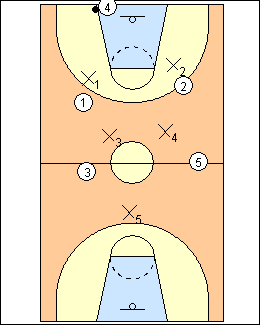 | 2 Deny option UConn will face guard attackers, making it a true fullcourt press (Fran Fraschilla). X5 defends the long pass, the other four defenders match up and play full denial to prevent an inbounds pass (coachesclipboard.net). X1 and X2 face guard to force a lob pass, X3 and X4 cheat up for a steal (Canisius College). The front line face guards to deny the inbounds pass, the trappers cheat up slightly to form longer ball-you-man (in your area) flat triangles (John Kimble). |
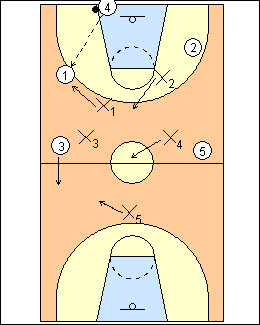 | 3 Defenders set up in the middle of the floor, match up with attackers in their area, then force (fan) the ball down the sideline. When ballside you defend inside out, otherwise defend the middle. The inbounds pass is not contested, but don't allow it in the middle. On the pass to O1, X1 immediately pressures the ball and forces sideline, X2 protects shallow middle. Other defenders cut off passing lanes. Ballside wing X3 has short sideline coverage, plays in the passing lane, and is ready to trap if the dribbler advances. The back person in the press (here X5) has long sideline responsibility, and the wing diagonal to the ball protects the basket. X2 is on a sharp angle with X1 (not as high), X4 on a sharp angle with X3 (Fraschilla). Kimble - X1 and X2 are usually halfway behind and halfway inside the first attacker in their areas, X3 and X4 near the sidelines at midcourt in ball-you-man flat triangles, X5 near the bottom of the centre circle. |
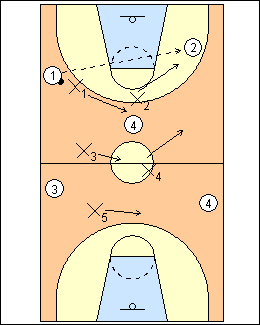 | 4 Do not allow vertical or diagonal passes up the floor (sideline, short or long middle). Ball reversal (a lateral pass) is normally not discouraged (UConn). If the ball is passed to O2, X1 and X2 scissor - X2 holds in the middle for a 1 or 2 count then is bumped by 1 to take the ball. X1 and X3 create sharp angles and X5 moves ballside. UConn makes the long diagonal pass very difficult to throw by placing good pressure on the ballhandler. Kimble match stunt - after the other team makes a designated number of reversal passes, all defenders match up to nearest attackers and defend man to man until the halfcourt defence is needed. |
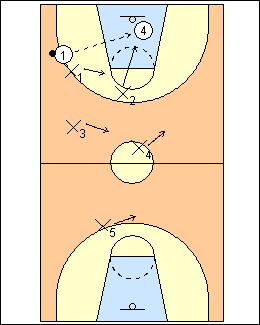 | 5 Options to defend ball reversal to the inbounder: - X1 and X2 scissor - X1 positions inside O1 to discourage the pass to O4 - X1 takes the ball on the pass to O4, allowing X2 to stay in the middle (Basketball Canada) - X1 or X2 takes the ball, whoever is closest (Canisius) - the zone goes back to the look it had before the inbounds pass, surrounding the middle and using up some of the backcourt count (Fraschilla) - match up into fullcourt man defence (Kimble match stunt). |
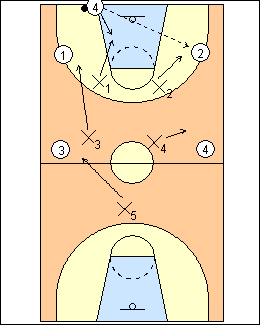 | 6 UConn match-up option - deny the reversal pass to the inbounder, e.g., when the inbounder is the best ballhandler (coachesclipboard.net). X1 takes the inbounder, X3 moves up to take O1, who is ordinarily X1's man, and X4 and X5 move to match up with frontcourt attackers. The weakside secondline defender must be ready to rotate and protect against a long pass when a trap is made. Canisius - the first adjustment is to deny a return pass back to the inbounder. |
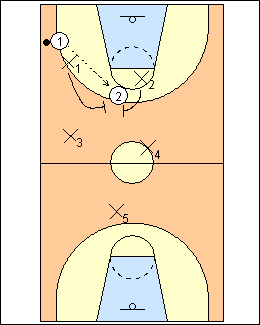 | 7 Other options - if the ball is passed to the middle behind the front line, X1 and X2 chase down and trap the ball, with X3 and X4 forming a triangle with the ball - X1 and X2 trap if the dribbler comes to the middle (Canisius) - if O1 dribbles middle, X2 helps then recovers when O1 passes (Pashutin, Russia). |
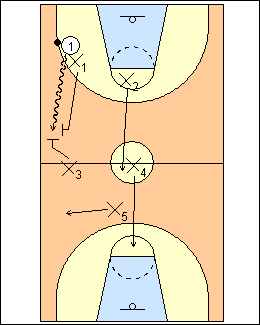 | 8 X3 hedges and recovers in the passing lane to encourage a lob pass then moves up to trap, X5 takes the sideline, X2 has short middle, and X4 has long middle. UConn - wants a good trap along either sideline, not necessarily an early one. Can create good traps in the backcourt and allow the reversal pass. Once the ball gets advanced just over halfcourt ideal trap situations arise, with less ground to cover if a trap is broken. Fraschilla - the safety is usually the best interceptor because he plays sideline to sideline. If he is a 3, then 4 and 5 play the wing positions, and a player of size would always be rotating back to protect the basket when the safety moves out to the sideline. Kimble In stunt - X1 fans O1 down the sideline then gets ahead of the dribbler, X3 covers up the sideline, X5 stays as safety, X4 covers short middle, X2 traps with X1. |
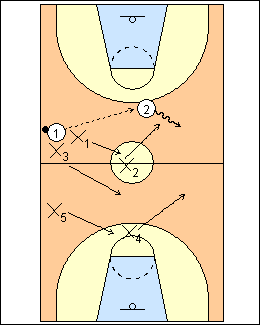 | 9 On ball reversal out of the trap, X5 recovers to the safety position |
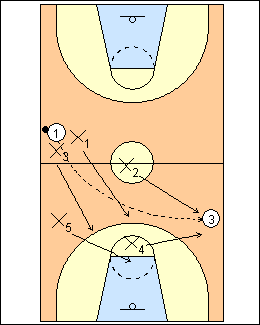 | 10 When 1 makes a cross-court pass, X2 and X4 trap on the other sideline. Fraschilla - if the skip pass is thrown from the attacking frontcourt, X2 chases down the ball and the other defenders retreat to the lane to build the halfcourt defence. |
 | 11 Grinnell College, Canisius - an ideal area to trap is just over halfcourt, especially on a pass. The onball defender forces sideline, the ballside wing defender plays even or below the wide offensive player, forcing him to break back to the ball. Receiver O2 can't make a return pass to O1 in their backcourt. If O1 dribbles up the sideline out of control, X3 can take a charge in this area, or trap with X1. |
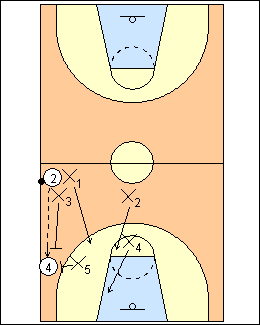 | 12 On a pass out of the trap up the sideline (or alley), X5 looks to steal the pass or trap with X3 if the pass is made. X3 and X1 sprint out of the trap. X4 covers the ballside block and basket, X2 takes anyone in the top of the key to elbow area, X1 takes any pass out of the trap back towards midcourt (UConn). Variations - X2 covers weakside in the lane - X1 covers the ballside elbow - trap only once, on the sideline either side of centre, e.g., against stronger teams, or fake traps (UConn). |
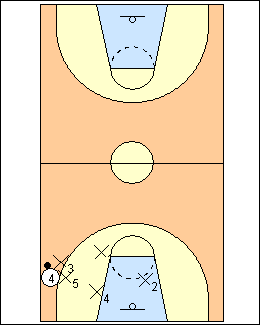 | 13 Here X2 covers weakside, X1 takes the ballside elbow. |
 | 14 Otherwise X5 forces the dribble sideline and baseline into a trap with X4. X2 rotates back as safety while X1 and X3 sprint out of the trap back to the lane (Fraschilla). |